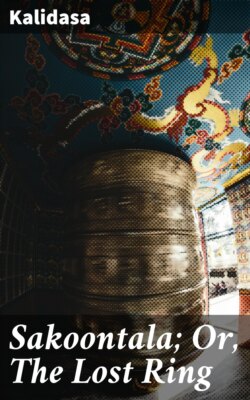Читать книгу Sakoontala; Or, The Lost Ring - Kalidasa - Страница 3
На сайте Литреса книга снята с продажи.
PREFACE TO THE EIGHTH EDITION.
ОглавлениеTable of Contents
The fact that the following translation (first published in 1855) of India's most celebrated drama has gone through seven editions, might reasonably have absolved me from the duty of revising it.
Three years ago, however, I heard that Sir John Lubbock had thought '[S']akoontalá' worthy of a place among the hundred best books of the world, and had adopted my version of the original. I therefore undertook to go through every line and once again compare the translation with the Sanskrit, in the hope that I might be able to give a few finishing touches to a performance which, although it had been before the public for about forty years, was certainly not perfect. The act of revision was a labour of love, and I can honestly say that I did my best to make my representation of Kálidása's immortal work as true and trustworthy as possible.
Another edition is now called for, but after a severely critical examination of every word, I have only detected a few minor unimportant points—and those only in the Introduction and Notes—in which any alteration appeared to be desirable. Indeed it is probable that the possessors of previous editions will scarcely perceive that any alterations have been made anywhere.
Occasionally in the process of comparison a misgiving has troubled me, and I have felt inclined to accuse myself of having taken, in some cases, too great liberties with the Sanskrit original. But in the end I have acquiesced in my first and still abiding conviction that a literal translation (such as that which I have given in the notes of my edition of the Sanskrit text) might have commended itself to Oriental students, but would not have given a true idea of the beauty of India's most cherished drama to general readers, whose minds are cast in a European mould, and who require a translator to clothe Oriental ideas, as far as practicable, in a dress conformable to European canons of taste.
And most assuredly such a translation would never have adapted itself to actual representation on a modern stage as readily as it now appears that my free version has done. It has gratified me exceedingly to find that youthful English-speaking Indians—cultured young men educated at the Universities of Calcutta, Madras and Bombay—have acted the [S']akoontalá, in the very words of my translation with the greatest success before appreciative audiences in various parts of India.
And lest any one in this country should be sceptical as to the possibility of interesting a modern audience in a play written possibly as early as the third or fourth century of our era (see p. xvi), I here append an extract from a letter received by me in 1893 from Mr. V. Padmanabha Aiyar, B.A., resident at Karamanai, Trivandrum, Travancore.
